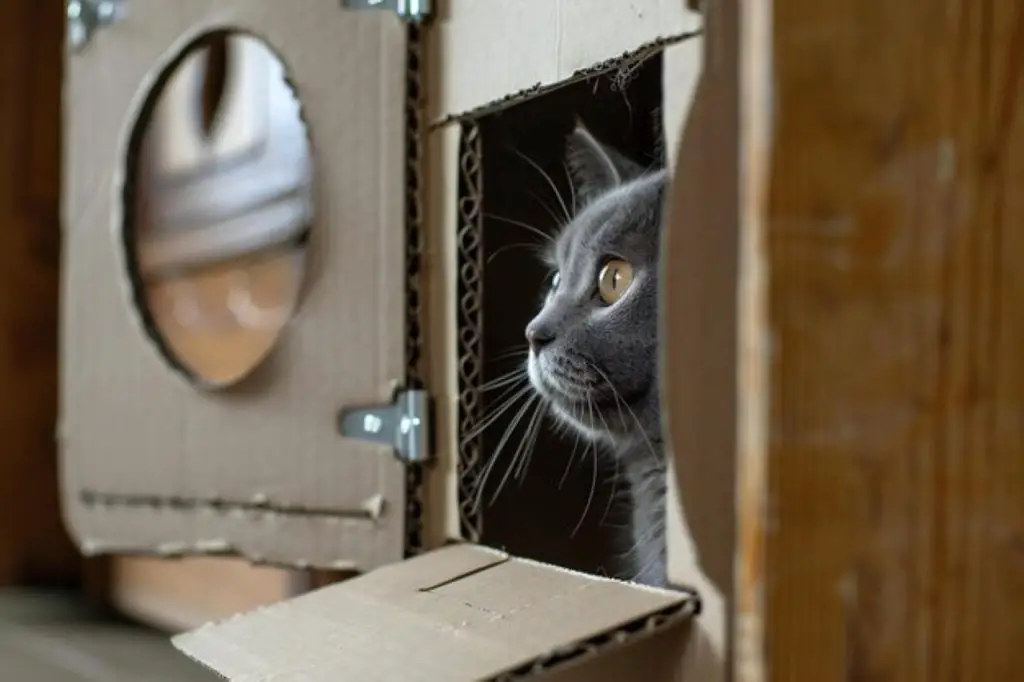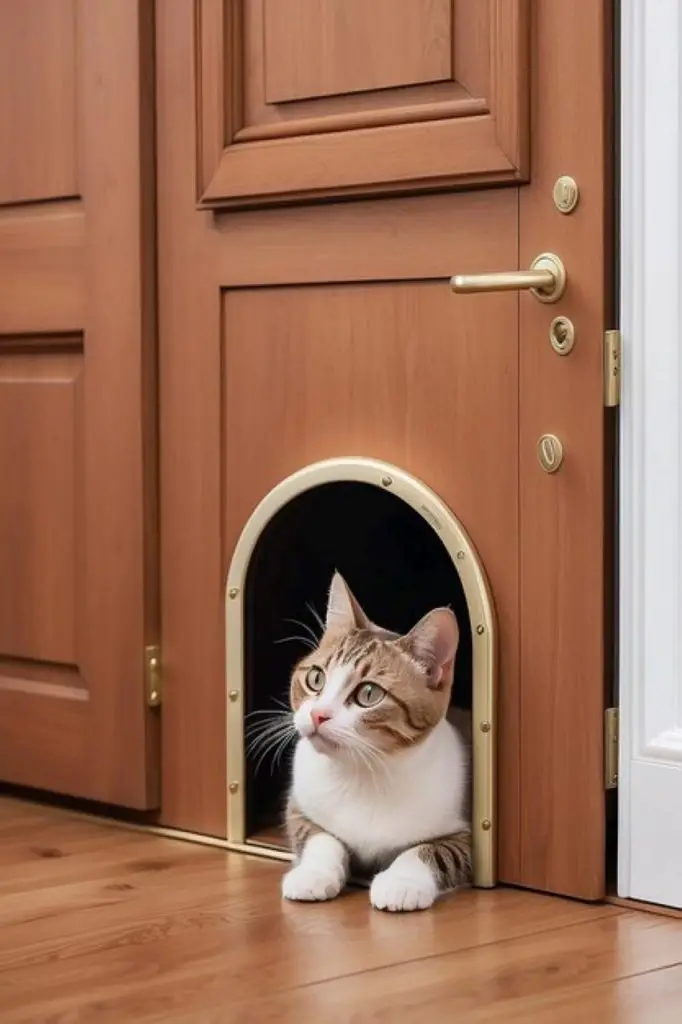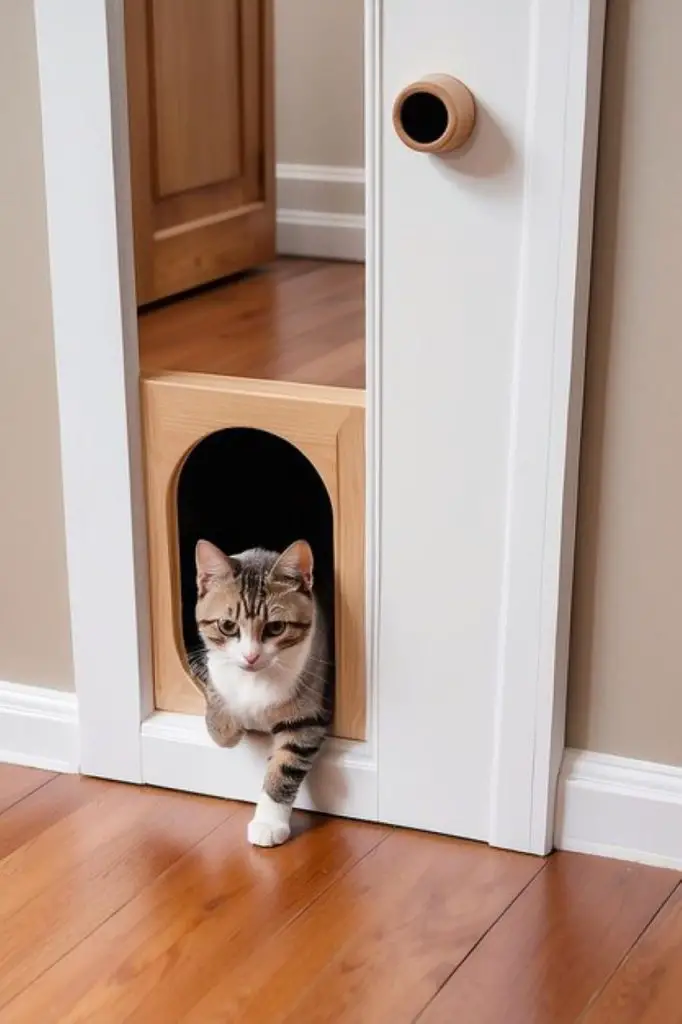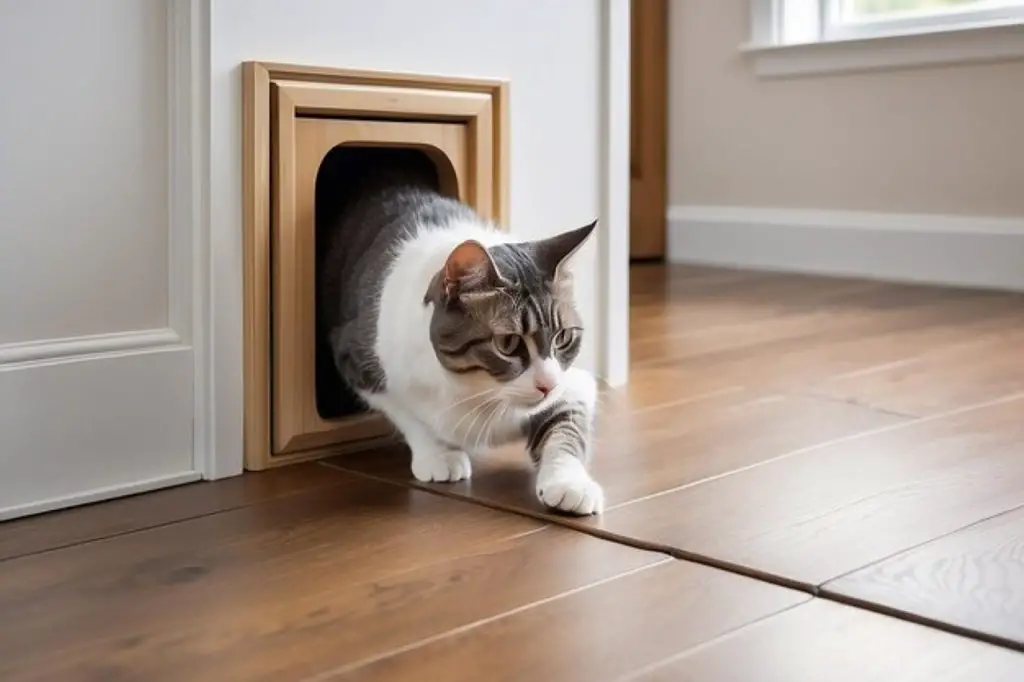
To train your cat to use a cat door, start by choosing the right door for your cat’s size and installing it correctly. Prepare your cat in advance by letting them observe the door from a distance and rewarding calm behavior. Gradually introduce the door to your cat, holding it open slightly to encourage exploration. Reward curiosity and bravery with treats and praise. As your cat becomes more confident, encourage them to pass through the doorway. With patience and consistent training, your cat will learn to use the door independently. By following a structured approach, you’ll set your cat up for success.
Table of Contents
Choose the Right Cat Door
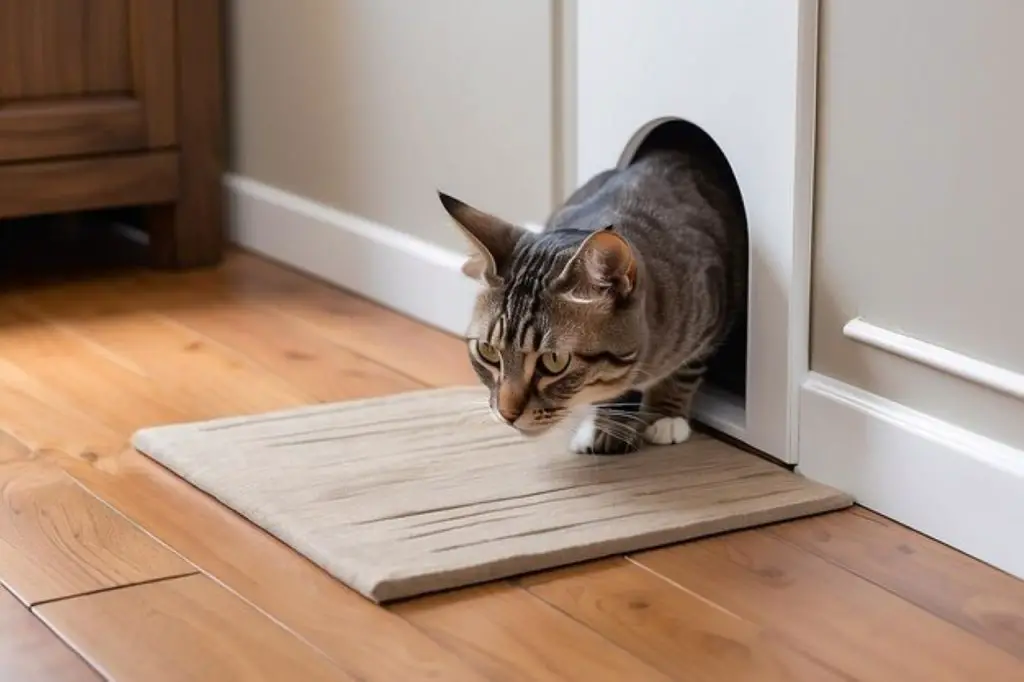
When selecting a cat door, you must consider several factors, including the size of your cat, the type of door or wall it will be installed in, and the level of security and energy efficiency you require.
You’ll find various cat door types, such as manual, automated, and magnetic options, each with distinct features. Manual doors are simple and cost-effective, while automated doors offer more convenience and security.
Magnetic doors, on the other hand, provide easy access and are often preferred by cats.
As you weigh your options, consider the material and durability of the door, as well as its insulation properties.
This post contains affiliate links. However all the information provided on this site are my own honest opinions. See more in Disclaimer.
Some cat doors come with additional features like draft stoppers or weatherstripping, which can help reduce heat transfer and prevent pests from entering.
Look for doors with adjustable settings and secure locking mechanisms to guarantee your home remains secure. By considering these factors and features, you can choose the right cat door for your feline friend and your home.
Prepare Your Cat in Advance

Having selected the right cat door for your home, you can now focus on preparing your cat to use it, which involves introducing the door gradually and making your cat comfortable with its presence.
Start by letting your cat see the door from a distance without allowing access to it, so they can become familiar with its appearance and smell.
As your cat becomes confident in the door’s presence, you can begin a gradual introduction process. Reward calm behavior around the door, such as sitting or approaching, with treats and vocal praise.
This positive reinforcement will help your cat associate good things with the door’s presence.
Monitor your cat’s behavior closely during each introduction step. If anxiety or fear is observed (e.g., hissing, tail flicking, or hiding), you’ll need to slow down to avoid creating a negative and lasting impression.
Remember patience is key, and respecting your cat’s boundaries from the start will lead ultimately to successful door use behaviors.
Install the Cat Door Correctly

To guarantee your cat uses the cat door successfully, you’ll need to install it correctly.
You’ll want to choose a location that’s convenient and quiet, allowing your cat to come and go without feeling anxious or stressed.
Choosing the Right Location
Selecting the ideal location for your cat door is vital for its effective use, so you’ll want to carefully consider factors such as foot traffic, weather, and your cat’s preferred paths in and out of the house.
To do this, observe your cat’s behavior, noting the routes they typically take when entering or exiting the house. You’ll want to place the cat door in a location that aligns with these paths, making it easy and convenient for your cat to use.
In addition to cat behavior, environmental factors also play an important role in determining the best location for the cat door. Avoid areas with high foot traffic, as this may discourage your cat from using the door.
Also, consider the impact of weather conditions, such as wind, rain, or direct sunlight, which may affect your cat’s comfort and willingness to use the door.
By taking the time to carefully evaluate these factors, you can choose a location that meets your cat’s needs and encourages them to use the cat door with ease.
This thoughtful placement will help guarantee a smooth changeover for your cat.
Securing the Door Frame
Mount the cat door securely in the door frame to prevent it from shifting or falling, which can startle your cat and discourage them from using it.
To guarantee a secure installation, you’ll need to evaluate the door frame materials and reinforcement. If your door frame is made of wood, you can use screws to secure the cat door.
However, if your door frame is made of metal or vinyl, you may need to use specialized screws or anchors to prevent damage.
Reinforcing the door frame with additional support, such as plywood or a door frame reinforcement kit, can also provide added security and stability.
This is particularly important if you have a large or energetic cat that will be using the door frequently.
Get Your Cat Used to Door
Your cat needs to become familiar with the cat door itself before they’ll feel comfortable using it. Understanding cat behavior is key to successful training.
To promote door familiarity, try the following steps:
- Let them see it: Place the cat door in a location where your cat spends most of their time, such as the kitchen or living room. This will allow them to become accustomed to its presence.
- Allow exploration: Let your cat approach the cat door at their own pace. They may sniff, paw, or even try to hide from it initially.
- Make it accessible: Once they seem comfortable with the door’s presence, try holding it open or slightly ajar. This will allow them to explore the other side without feeling confined.
- Observe body language: Pay attention to your cat’s posture and behavior around the door. If they appear tense or fearful, it’s best to slow down the training process.
Reward Curiosity and Bravery
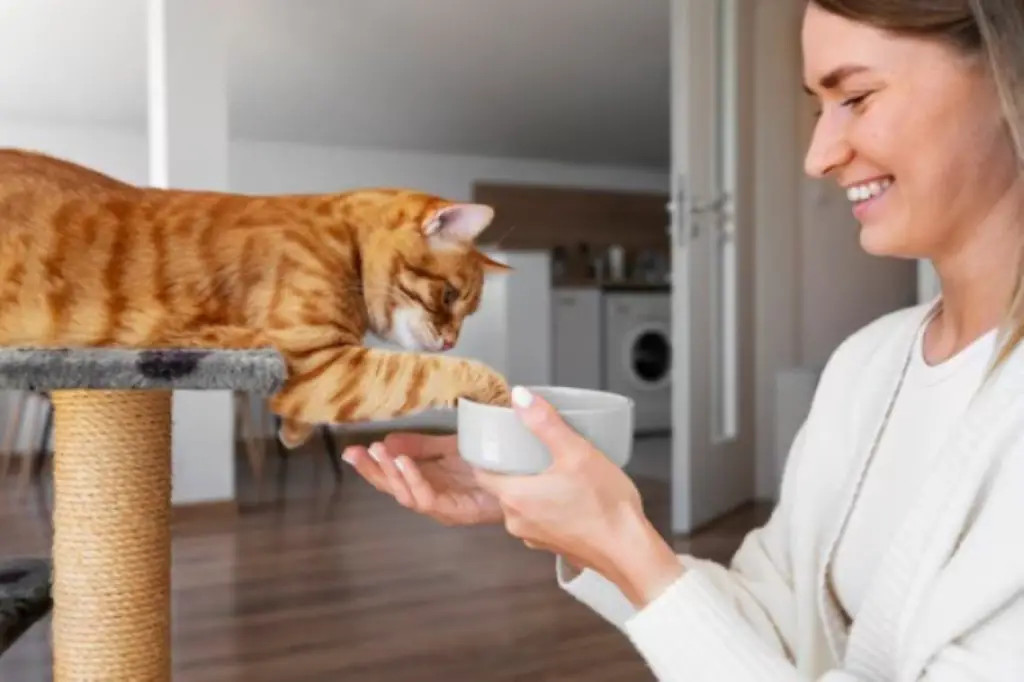
As your cat becomes more comfortable with the cat door, it’s time to start encouraging their curiosity and bravery with rewards, which will help build their confidence and ultimately lead to successful use of the door.
You can start by offering treats or toys near the cat door, enticing your cat to come closer and investigate. When they do, be sure to provide curiosity rewards, such as praise or treats, to reinforce their behavior.
As your cat becomes bolder, you can start providing bravery boosts, such as treats or playtime, when they exhibit courageous behavior around the cat door.
For example, if your cat touches the door or tries to push it open, be sure to reward them with a treat or praise.
Encourage Through the Doorway
Now that curiosity and bravery have been rewarded, it’s time to take the next step: gently coaxing the cat through the doorway itself, an essential milestone in training the cat to use the cat door successfully.
You’ll use positive reinforcement to encourage the cat to move through the doorway, making the experience enjoyable and rewarding.
To create a smooth progression, try these doorway games:
- Treat Trail: Place treats on both sides of the doorway, creating a trail for the cat to follow. This will help the cat associate the doorway with a pleasant experience.
- Toy Tease: Use a toy to entice the cat through the doorway, making it a fun and engaging experience.
- Personal Guidance: Gently guide the cat through the doorway while providing reassurance and rewards.
- Verbal Encouragement: Use a soothing voice to encourage the cat to move through the doorway, making it a calm and comfortable experience.
Gradually Phase Out Assistance

As your cat becomes more comfortable using the cat door, you’ll start to phase out the assistance you’ve been providing.
You’ll begin by supervising their comings and goings, then gradually reduce your involvement, rewarding them for independent use.
Start With Supervision
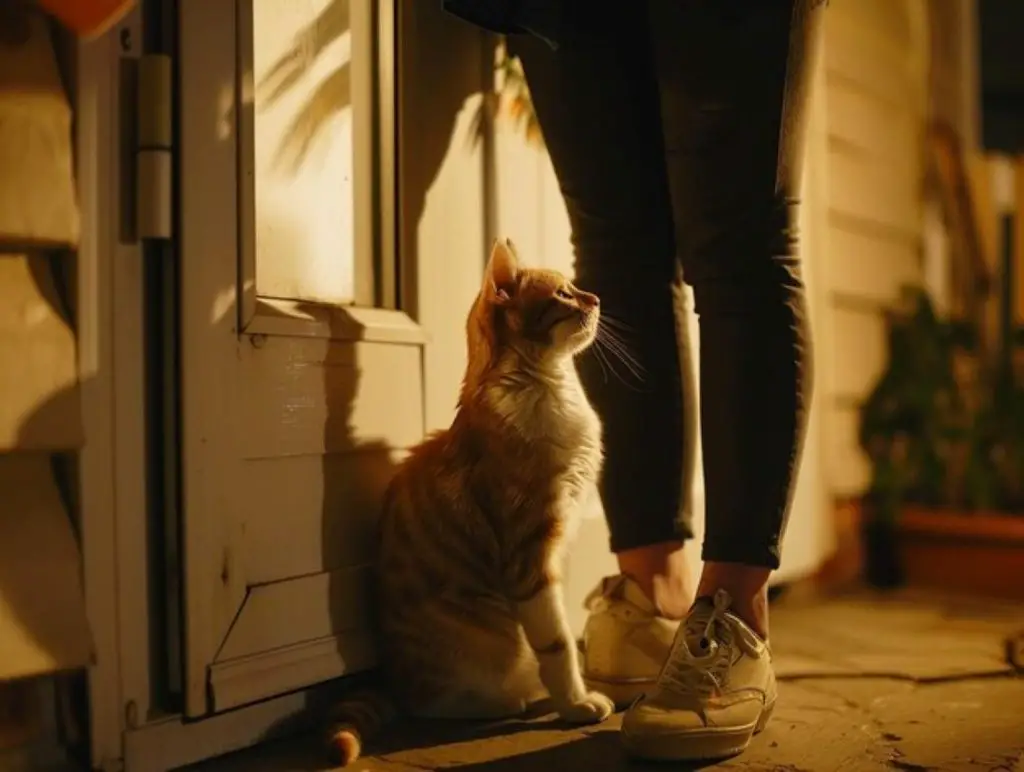
Supervising your cat as they learn to use the cat door allows you to provide assistance and correct any mistakes, ensuring they develop good habits from the start.
During these supervised sessions, you’ll be able to gauge your cat’s comfort level and adjust the training pace accordingly. It’s crucial to provide gradual exposure to the cat door to prevent overwhelming your cat.
Here are some key things to keep in mind during supervised sessions:
- Observe body language: Watch for signs of stress or anxiety, such as tail twitching or flattening ears.
- Provide guidance: Gently encourage your cat to approach and use the cat door.
- Correct mistakes: If your cat tries to use the door incorrectly, calmly redirect them to the proper entrance.
- Offer reassurance: Reward your cat with praise and affection when they successfully use the cat door.
Reward Independent Use

By gradually phasing out your assistance, you’ll encourage your cat to develop the confidence to use the cat door independently, allowing them to come and go as they please.
As your cat becomes more comfortable with the door, start to reduce the amount of guidance you provide. Instead, offer treat rewards when they successfully navigate the door on their own.
This positive reinforcement will help build their confidence and encourage repeat behavior.
When your cat uses the door independently, be sure to praise them and provide rewards immediately. This association will help them understand that using the door is a desirable behavior.
You can also try hiding on the other side of the door and calling your cat through, rewarding them with treats when they come through successfully.
By consistently reinforcing independent use, you’ll help your cat develop the skills and confidence they need to use the cat door without assistance.
Monitor Progress Closely
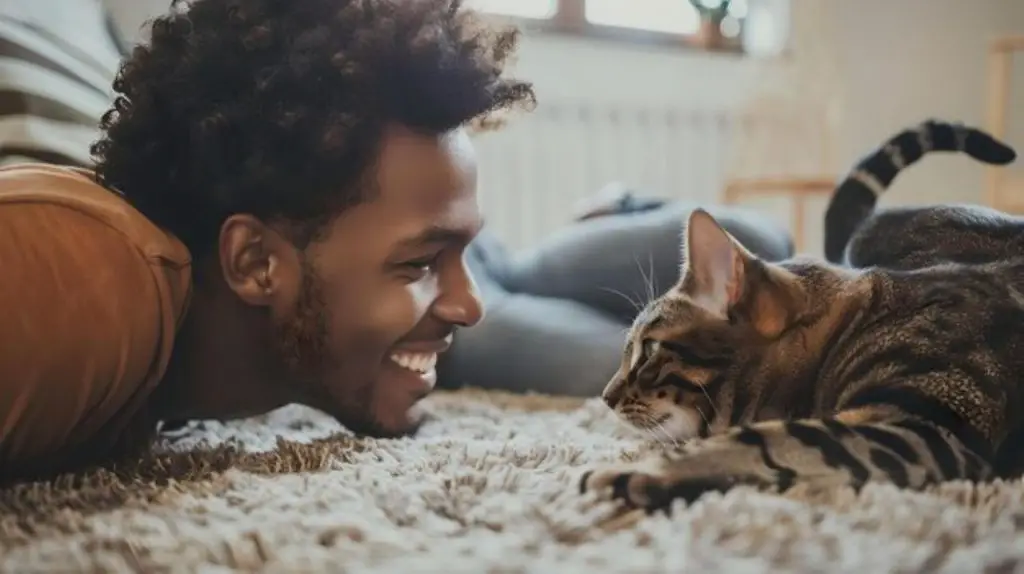
Closely monitoring your cat’s progress allows you to gauge their comfort level with the cat door and determine the right pace for phasing out your assistance.
You’ll need to pay attention to behavioral cues, such as hesitation or enthusiasm, to adjust your training strategy. By tracking progress, you can identify areas where your cat needs more encouragement or support.
Here are some key things to look out for:
- Increased independence: Is your cat using the door with less hesitation or prompting from you?
- Improved speed: Are they able to pass through the door quickly and confidently?
- Reduced stress: Do they seem more relaxed when approaching or using the door?
- Consistency: Are they using the door consistently, or are there specific times or situations that still cause hesitation?
Monitor Progress and Be Patient

As you encourage your cat to use the cat door, tracking their progress and adjusting your training strategy accordingly is vital to overcoming any setbacks or plateaus that may arise.
You’ll want to monitor your cat’s behavior and reactions to the cat door, taking note of any successes or challenges they encounter.
This progress tracking will help you identify areas where your cat needs more support or encouragement, allowing you to adjust your training approach as needed.
To guarantee successful training, it’s also important to employ patience strategies. Training a cat to use a cat door can take time, and it’s necessary to avoid rushing the process or putting pressure on your cat.
Instead, focus on gradual, gentle encouragement, rewarding your cat for small successes and providing reassurance when they encounter difficulties.
By combining progress tracking with patience strategies, you’ll be well on your way to helping your cat master the cat door.
Frequent Questions
“Congratulations, you’ve decided to turn your home into a feline freeway! You can install cat doors in both walls and doors. Various cat door types accommodate wall installation, so choose one that fits your DIY skills.”
You can install cat doors in metal or glass doors, but it depends on the cat door type and installation materials. Some cat doors are specifically designed for metal or glass doors, so choose the right one for a smooth installation.
You’ll need to implement animal deterrents, such as magnetic or RFID-activated door security, to prevent other animals from accessing your home through the cat door; you’ll also want to contemplate a secure locking mechanism.
“Are you willing to risk your security deposit for your cat’s freedom? Check your rental agreement for cat door regulations and get written permission from your landlord before installing a cat door to avoid any potential issues.”
You’re likely wondering if a cat door will hike up your energy bills. Generally, the increase in energy consumption is minimal, and a cost comparison with keeping windows open or using air conditioning may surprise you.



